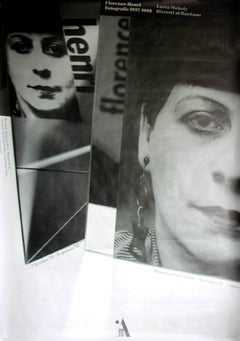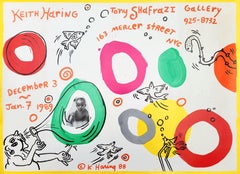Bruno Monzuzzi Figurative Prints
to
1
Overall Width
to
Overall Height
to
2
846
382
380
308
1
1
1
1
1
1
1
1
1
1
1
Artist: Bruno Monzuzzi
Florence Henri
By Bruno Monzuzzi
Located in New York, NY
Ritratti al Bauhaus. Photo-offset poster.
Museo cantonale d'arte Lugano
Year: 1991.
Monguzzi studied in Geneva and London, spent part of his early career in at the studio of Antonio Boggeri, in Milan. The inspiration of the experimental and visually-daring work of the avant garde designers Herbert Bayer, El Lissitsky, Jan Tschichold, Piet Zwart, Paul Schuitema, Ladislav Sutnar...
Category
1990s Bauhaus Bruno Monzuzzi Figurative Prints
Materials
Offset
Related Items
Keith Haring: Tony Shafrazi Gallery Poster /// New York Street Pop Art Exhibit
By Keith Haring
Located in Saint Augustine, FL
Artist: Keith Haring (American, 1958-1990)
Title: "Keith Haring: Tony Shafrazi Gallery"
*Signed and dated by Haring in the plate (printed signature) lower center
Year: 1988
Medium: O...
Category
1980s Pop Art Bruno Monzuzzi Figurative Prints
Materials
Lithograph, Offset
$1,400
H 25.19 in W 34.32 in
Sale and Marketing Kiosk for P Cigarettes (Bauhaus) (20% OFF + Free Shipping)
By Herbert Bayer
Located in Kansas City, MO
Herbert Bayer
Sale and Marketing Kiosk for P Cigarettes (Verkauf- und Werbekiosk, Zigarettenmarke P ), 1924
Offset Lithograph
Year: 1994
Size: 33.2 × 23.2 inches
Publisher: Bauhaus A...
Category
1920s Bauhaus Bruno Monzuzzi Figurative Prints
Materials
Lithograph
$120 Sale Price
20% Off
H 33.2 in W 23.2 in
Young Hearts, Portland Gallery London offset lithograph
By Jack Vettriano
Located in Hillsborough, NC
Jack Vettriano (1951-) is renowned for his film noir oil paintings and 1930s glam style. Uniquely Vettriano, ‘Young Hearts’ is set by the seaside inviting narratives about the figures in his work: relationships, anticipation, power and suggestion.
Vettriano grew up by the Fife Scottish coast. He began painting beach scenes as a young adult, later developing his particular recognizable style and thematic imagery. His work was embraced by celebrities such as Madonna and Jack Nicholson and he has become hugely successful. His most famous painting, ‘The Singing Butler...
Category
Early 2000s Contemporary Bruno Monzuzzi Figurative Prints
Materials
Lithograph, Offset
Pop Shop Poster /// Keith Haring New York Street Pop Art Figurative Lithograph
By Keith Haring
Located in Saint Augustine, FL
Artist: Keith Haring (American, 1958-1990)
Title: "Pop Shop"
*Signed by Haring in the plate (printed signature) center right
Year: 1986
Medium: Original Offset-Lithograph, Poster on ...
Category
1980s Pop Art Bruno Monzuzzi Figurative Prints
Materials
Lithograph, Offset
$2,200
H 34 in W 22.07 in
TAKASHI MURAKAMI DOB & Me On the Red... Hand signed & numbered Superflat Pop Art
By Takashi Murakami
Located in Madrid, Madrid
DOB & Me: On the Red Mound of the Dead
Date of creation: 2013
Medium: Offset lithograph with silver on paper
Edition: 300
Size: 50 x 50 cm
Condition: In mint conditions and not frame...
Category
2010s Pop Art Bruno Monzuzzi Figurative Prints
Materials
Varnish, Lithograph, Offset
$2,942
H 19.69 in W 19.69 in
TAKASHI MURAKAMI: DOB: Myxomycete - Superflat, Japanese Pop Art
By Takashi Murakami
Located in Madrid, Madrid
DOB: MYXOMYCETE
Date of creation: 2017
Medium: Offset lithograph with cold stamp on paper
Edition: 300
Size: 68 x 68 cm
Condition: In mint conditions, brand new and never framed
Obse...
Category
2010s Pop Art Bruno Monzuzzi Figurative Prints
Materials
Varnish, Lithograph, Offset
$3,832
H 26.78 in W 26.78 in
TAKASHI MURAKAMI: And Then x 727 (Vermillion SHU) Hand signed Superflat, Pop Art
By Takashi Murakami
Located in Madrid, Madrid
And Then x 727 (Vermillion SHU)
Date of creation: 2013
Medium: Offset lithograph with silver
Media: Paper
Edition: 300
Size: 50 x 50 cm
Observations: And Then x 727 (Vermillion SHU) ...
Category
2010s Pop Art Bruno Monzuzzi Figurative Prints
Materials
Varnish, Lithograph, Offset
$3,832
H 19.69 in W 19.69 in
I Am The Last Of My Kind
By Tracey Emin
Located in London, GB
Published by the Royal Academy
Category
2010s Contemporary Bruno Monzuzzi Figurative Prints
Materials
Lithograph, Offset
TAKASHI MURAKAMI: And Then x6 (Blue) Hand signed & numb. Superflat, Pop Art
By Takashi Murakami
Located in Madrid, Madrid
And Then x 6 (Blue: The Polke Method)
Date of creation: 2015
Medium: Offset lithograph with silver
Media: Paper
Edition: 300
Size: 50 x 50 cm
Observations: Offset lithograph with sil...
Category
2010s Pop Art Bruno Monzuzzi Figurative Prints
Materials
Varnish, Lithograph, Offset
$3,832
H 19.69 in W 19.69 in
TAKASHI MURAKAMI DOB & Me On the Red... Hand signed & numbered Superflat Pop Art
By Takashi Murakami
Located in Madrid, Madrid
TAKASHI MURAKAMI - Time Bokan Black
Date of creation: 2011
Medium: Offset lithograph with silver on paper
Edition: 300
Size: 50 x 50 cm
Condition: In mint conditions and not framed
O...
Category
2010s Pop Art Bruno Monzuzzi Figurative Prints
Materials
Varnish, Lithograph, Offset
$3,124
H 19.69 in W 19.69 in
I Am The Last Of My Kind
By Tracey Emin
Located in London, GB
Published by the Royal Academy
Category
2010s Contemporary Bruno Monzuzzi Figurative Prints
Materials
Lithograph, Offset
TAKASHI MURAKAMI - HOMAGE TO FRANCIS BACON DIPTYCH Superflat, Pop Art
By Takashi Murakami
Located in Madrid, Madrid
HOMAGE TO FRANCIS BACON (STUDY FOR HEAD OF ISABEL RAWSTHORNE AND GEORGE DYER)
Date of creation: 2016
Medium: Offset lithograph with cold foil stamp on paper
Edition: 300
Size: 50 x 5...
Category
2010s Pop Art Bruno Monzuzzi Figurative Prints
Materials
Lithograph, Offset
$6,485
H 19.69 in W 19.69 in
Bruno Monzuzzi figurative prints for sale on 1stDibs.
Find a wide variety of authentic Bruno Monzuzzi figurative prints available for sale on 1stDibs. You can also browse by medium to find art by Bruno Monzuzzi in offset print and more. Not every interior allows for large Bruno Monzuzzi figurative prints, so small editions measuring 36 inches across are available. Customers who are interested in this artist might also find the work of and Lyonel Feininger. Bruno Monzuzzi figurative prints prices can differ depending upon medium, time period and other attributes. On 1stDibs, the price for these items starts at $900 and tops out at $900, while the average work can sell for $900.


